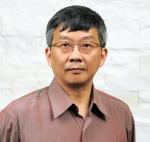Gruznev, D. V., Matetskiy A. V., Zotov A. V., Saranin A. A., Chou J. P., Wei C. M., & Wang Y. L.
(2011).
Interplay between adsorbed C-60 fullerenes and point defects on a Si(111)root 3 x root 3-In reconstructed surface.
Surface Science. 605, 2050-2054., Dec, Number 23-24
AbstractAdsorption of C-60 onto Si(111)root 3 x root 3-In surface presents a fascinating example of interplay between molecular adsorbate and surface structural defects. It has been found that adsorbing C-60 molecules are trapped by the substitutional Si-defects. In turn, the group of a few adsorbed C-60 can act as a trap for the mobile vacancies of the root 3 x root 3-In reconstruction. Namely, adsorbed C-60 induces a strain in the indium layer, and when a mobile vacancy happens to get into the surface area surrounded by fullerenes, the In atoms between the C-60 and the vacancy shift from the T-4 to the H-3 sites, fixing a vacancy in a given location. (C) 2011 Elsevier B.V. All rights reserved.
